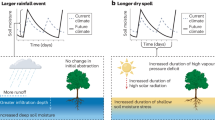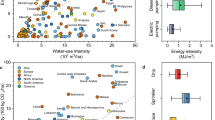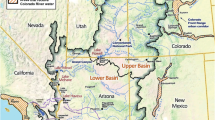Abstract
Avoiding excessive agricultural nitrogen (N) use without compromising yields has long been a priority for both research and government policy in China1,2. Although numerous rice-related strategies have been proposed3,4,5, few studies have assessed their impacts on national food self-sufficiency and environmental sustainability and fewer still have considered economic risks faced by millions of smallholders. Here we established an optimal N rate strategy based on maximizing either economic (ON) or ecological (EON) performance using new subregion-specific models. Using an extensive on-farm dataset, we then assessed the risk of yield losses among smallholder farmers and the challenges of implementing the optimal N rate strategy. We find that meeting national rice production targets in 2030 is possible while concurrently reducing nationwide N consumption by 10% (6–16%) and 27% (22–32%), mitigating reactive N (Nr) losses by 7% (3–13%) and 24% (19–28%) and increasing N-use efficiency by 30% (3–57%) and 36% (8–64%) for ON and EON, respectively. This study identifies and targets subregions with disproportionate environmental impacts and proposes N rate strategies to limit national Nr pollution below proposed environmental thresholds, without compromising soil N stocks or economic benefits for smallholders. Thereafter, the preferable N strategy is allocated to each region based on the trade-off between economic risk and environmental benefit. To facilitate the adoption of the annually revised subregional N rate strategy, several recommendations were provided, including a monitoring network, fertilization quotas and smallholder subsidies.
This is a preview of subscription content, access via your institution
Access options
Access Nature and 54 other Nature Portfolio journals
Get Nature+, our best-value online-access subscription
$29.99 / 30 days
cancel any time
Subscribe to this journal
Receive 51 print issues and online access
$199.00 per year
only $3.90 per issue
Buy this article
- Purchase on Springer Link
- Instant access to full article PDF
Prices may be subject to local taxes which are calculated during checkout





Similar content being viewed by others
Data availability
The core data for the study were obtained from the selected studies (see supplementary references), including their supplementary information and data files. All model input datasets and the extensive on-farm data are available at https://doi.org/10.5281/zenodo.7307739.
Code availability
The code to replicate the key findings and figures of the paper are available at https://github.com/CarolejaneCosmos/Optimal_N_rice_China. Further code is available from the corresponding author on reasonable request. Maps in the study were generated in R version 4.0.1 using map data from the Resource and Environment Science and Data Center (https://www.resdc.cn/data.aspx?DATAID=202).
References
Guo, Y. et al. Air quality, nitrogen use efficiency and food security in China are improved by cost-effective agricultural nitrogen management. Nat. Food 1, 648–658 (2020).
Liu, X. et al. Environmental impacts of nitrogen emissions in China and the role of policies in emission reduction. Philos. Trans. R. Soc. A Math. Phys. Eng. Sci. 378, 20190324 (2020).
Yin, Y. et al. A steady-state N balance approach for sustainable smallholder farming. Proc. Natl Acad. Sci. USA 118, e2106576118 (2021).
Cui, Z. et al. Pursuing sustainable productivity with millions of smallholder farmers. Nature 555, 363–366 (2018).
Yin, Y. et al. Calculating socially optimal nitrogen (N) fertilization rates for sustainable N management in China. Sci. Total Environ. 688, 1162–1171 (2019).
Alexandratos, N. (ed.) World Food and Agriculture to 2030/50. Highlights and Views from Mid-2009 (FAO, 2009).
Cassman, K. G. & Grassini, P. A global perspective on sustainable intensification research. Nat. Sustain. 3, 262–268 (2020).
Jenkinson, D. S. The impact of humans on the nitrogen cycle, with focus on temperate arable agriculture. Plant Soil 228, 3–15 (2001).
Lee, M., Shevliakova, E., Stock, C. A., Malyshev, S. & Milly, P. C. D. Prominence of the tropics in the recent rise of global nitrogen pollution. Nat. Commun. 10, 1437 (2019).
Sutton, M. A. et al. Our Nutrient World. The Challenge to Produce More Food and Energy with Less Pollution (Centre for Ecology and Hydrology, 2013).
Hill, J. et al. Air-quality-related health damages of maize. Nat. Sustain. 2, 397–403 (2019).
Sobota, D. J., Compton, J. E., McCrackin, M. L. & Singh, S. Cost of reactive nitrogen release from human activities to the environment in the United States. Environ. Res. Lett. 10, 025006 (2015).
Keeler, B. L. et al. The social costs of nitrogen. Sci. Adv. 2, e1600219 (2016).
Dobermann, A. et al. Responsible plant nutrition: a new paradigm to support food system transformation. Global Food Secur. 33, 100636 (2022).
Zhang, D. et al. Nitrogen application rates need to be reduced for half of the rice paddy fields in China. Agric. Ecosyst. Environ. 265, 8–14 (2018).
Chen, X. et al. Producing more grain with lower environmental costs. Nature 514, 486–489 (2014).
Conant, R. T., Berdanier, A. B. & Grace, P. R. Patterns and trends in nitrogen use and nitrogen recovery efficiency in world agriculture. Global Biogeochem. Cycles 27, 558–566 (2013).
Ministry of Agriculture and Rural Affairs of the People’s Republic of China. Circular of the Ministry of Agriculture on Printing and Distributing the Action Plan for Zero Growth in the Application of Fertilizer by 2020 and the Action Plan for Zero Growth in the Application of Pesticide by 2020 (Ministry of Agriculture, 2015).
Zhang, X. et al. Managing nitrogen for sustainable development. Nature 528, 51–59 (2015).
Yan, X., Xia, L. & Ti, C. Temporal and spatial variations in nitrogen use efficiency of crop production in China. Environ. Pollut. 293, 118496 (2022).
Kanter, D. R. & Searchinger, T. D. A technology-forcing approach to reduce nitrogen pollution. Nat. Sustain. 1, 544–552 (2018).
Wu, L., Chen, X., Cui, Z., Wang, G. & Zhang, W. Improving nitrogen management via a regional management plan for Chinese rice production. Environ. Res. Lett. 10, 095011 (2015).
Cui, Z., Chen, X. & Zhang, F. Development of regional nitrogen rate guidelines for intensive cropping systems in China. Agron. J. 105, 1411–1416 (2013).
Zhao, X., Nafziger, E. D. & Pittelkow, C. M. Nitrogen rate strategies for reducing yield-scaled nitrous oxide emissions in maize. Environ. Res. Lett. 12, 124006 (2017).
Sachs, J. D. et al. Six transformations to achieve the Sustainable Development Goals. Nat. Sustain. 2, 805–814 (2019).
Cai, S., Pittelkow, C. M., Zhao, X. & Wang, S. Winter legume-rice rotations can reduce nitrogen pollution and carbon footprint while maintaining net ecosystem economic benefits. J. Cleaner Prod. 195, 289–300 (2018).
Ministry of Agriculture and Rural Affairs of the People’s Republic of China. Maximum N Application Rate for Rice in China (Department of Crop Production, 2020).
United Nations, Department of Economic and Social Affairs, Population Division. World Population Prospects 2019. Volume I: Comprehensive Tables (United Nations, 2019).
de Vries, W., Kros, J., Kroeze, C. & Seitzinger, S. P. Assessing planetary and regional nitrogen boundaries related to food security and adverse environmental impacts. Curr. Opin. Environ. Sustain. 5, 392–402 (2013).
Leip, A., Britz, W., Weiss, F. & de Vries, W. Farm, land, and soil nitrogen budgets for agriculture in Europe calculated with CAPRI. Environ. Pollut. 159, 3243–3253 (2011).
Zhao, Y. et al. Economics- and policy-driven organic carbon input enhancement dominates soil organic carbon accumulation in Chinese croplands. Proc. Natl Acad. Sci. USA 115, 4045–4050 (2018).
Liu, C., Lu, M., Cui, J., Li, B. & Fang, C. Effects of straw carbon input on carbon dynamics in agricultural soils: a meta-analysis. Global Change Biol. 20, 1366–1381 (2014).
Pan, G. et al. Combined inorganic/organic fertilization enhances N efficiency and increases rice productivity through organic carbon accumulation in a rice paddy from the Tai Lake region, China. Agric. Ecosyst. Environ. 131, 274–280 (2009).
Yan, X., Yagi, K., Akiyama, H. & Akimoto, H. Statistical analysis of the major variables controlling methane emission from rice fields. Global Change Biol. 11, 1131–1141 (2005).
Pittelkow, C. M. et al. Yield-scaled global warming potential of annual nitrous oxide and methane emissions from continuously flooded rice in response to nitrogen input. Agric. Ecosyst. Environ. 177, 10–20 (2013).
Zhang, W. et al. Closing yield gaps in China by empowering smallholder farmers. Nature 537, 671–674 (2016).
Sawyer, J. et al. Concepts and Rationale for Regional Nitrogen Rate Guidelines for Corn (Iowa State University Extension and Outreach, 2006).
Qiao, L. et al. Soil quality both increases crop production and improves resilience to climate change. Nat. Clim. Change 12, 574–580 (2022).
Kuhn, T. et al. Coupling crop and bio-economic farm modelling to evaluate the revised fertilization regulations in Germany. Agric. Syst. 177, 102687 (2020).
Pan, D., Tang, J., Zhang, L., He, M. & Kung, C.-C. The impact of farm scale and technology characteristics on the adoption of sustainable manure management technologies: evidence from hog production in China. J. Cleaner Prod. 280, 124340 (2021).
Wu, Y. et al. Policy distortions, farm size, and the overuse of agricultural chemicals in China. Proc. Natl Acad. Sci. USA 115, 7010 (2018).
Wang, S. et al. Urbanization can benefit agricultural production with large-scale farming in China. Nat. Food 2, 183–191 (2021).
Kanter, D. R. et al. Nitrogen pollution policy beyond the farm. Nat. Food 1, 27–32 (2020).
Huang, J., Wang, X. & Rozelle, S. The subsidization of farming households in China’s agriculture. Food Policy 41, 124–132 (2013).
Roberts, T., Ross, W., Norman, R., Slaton, N. & Wilson, C. Jr Predicting nitrogen fertilizer needs for rice in Arkansas using alkaline hydrolyzable‐nitrogen. Soil Sci. Soc. Am. J. 75, 1161–1171 (2011).
Huang, S. et al. Satellite remote sensing-based in-season diagnosis of rice nitrogen status in Northeast China. Remote Sens. 7, 10646–10667 (2015).
Purba, J. et al. Site-specific fertilizer nitrogen management in irrigated transplanted rice (Oryza sativa) using an optical sensor. Precis. Agric. 16, 455–475 (2015).
Xia, L. et al. Can knowledge-based N management produce more staple grain with lower greenhouse gas emission and reactive nitrogen pollution? A meta-analysis. Global Change Biol. 23, 1917–1925 (2017).
Rural Social Economic Investigation Department of National Bureau of Statistics. China Rural Statistical Yearbook (China Statistics Press, 2019).
China Agricultural Yearbook Editorial Committee. China Agricultural Yearbook 2016 (China Agriculture Press, 2017).
Zuur, A. F., Ieno, E. N., Walker, N. P. J., Saveliev, A. A. & Smith, G. M. Mixed Effects Models and Extensions in Ecology with R (Springer, 2009).
R Core Team. R: A Language and Environment for Statistical Computing, Vol. 1 (R Foundation for Statistical Computing, 2014).
Nakagawa, S. & Schielzeth, H. A general and simple method for obtaining R2 from generalized linear mixed‐effects models. Methods Ecol. Evol. 4, 133–142 (2013).
Bolker, B. M. Ecological Models and Data in R (Princeton Univ. Press; 2008).
IPCC. Working Group I Contribution to the Sixth Assessment Report of the Intergovernmental Panel on Climate Change, Vol. 4 (Cambridge Univ. Press, 2021).
Zhu, Z.-l. in Nitrogen in Soils of China (eds Zhu, Z.-l., Wen, Q.-x. & Freney, J. R.) 323–338 (Springer, 1997).
Xu, W. et al. Quantifying atmospheric nitrogen deposition through a nationwide monitoring network across China. Atmos. Chem. Phys. 15, 12345–12360 (2015).
China National Environmental Monitoring Centre, weekly. http://www.cnemc.cn/sssj/szzdjczb/ (CNEMC, 2020).
He, G., Wang, Z. & Cui, Z. Managing irrigation water for sustainable rice production in China. J. Cleaner Prod. 245, 118928 (2020).
Food and Agriculture Organization of the United Nations. Technical Conversion Factors for Agricultural Commodities (FAO, 2017).
He, W. et al. Estimating soil nitrogen balance at regional scale in China’s croplands from 1984 to 2014. Agric. Syst. 167, 125–135 (2018).
Zhu, Z.-l. in Nitrogen in Soils of China (eds Zhu, Z.-l., Wen, Q.-x. & Freney, J. R.) 239–279 (Springer, 1997).
Zhang, A. et al. Using side-dressing technique to reduce nitrogen leaching and improve nitrogen recovery efficiency under an irrigated rice system in the upper reaches of Yellow River Basin, Northwest China. J. Integr. Agric. 15, 220–231 (2016).
Acknowledgements
This work was supported by the Youth Innovation Promotion Association, the Chinese Academy of Sciences (Y201956), the National Natural Science Foundation of China (42061124001) and the National Key R&D Program of China (2017YFD0200104). M.F. was funded by the National Natural Science Foundation of China (31972520). X. Zhang was supported by the National Science Foundation (CBET-2047165 and CBET-2025826).
Author information
Authors and Affiliations
Contributions
X. Zhao, C.M.P. and X.Y. conceptualized the research. S.C. and X. Zhao contributed to the acquisition and analysis of data. M.F. provided the extensive on-farm trials dataset. S.C., C.M.P. and X. Zhao wrote the manuscript. X. Zhang reviewed and edited the original draft. X. Zhang, X.Y. and M.F. commented on the manuscript.
Corresponding authors
Ethics declarations
Competing interests
The authors declare no competing interests.
Peer review
Peer review information
Nature thanks Baojing Gu and the other, anonymous, reviewer(s) for their contribution to the peer review of this work.
Additional information
Publisher’s note Springer Nature remains neutral with regard to jurisdictional claims in published maps and institutional affiliations.
Extended data figures and tables
Extended Data Fig. 1 Total Nr losses, economic benefit and NEEB response to the N rate.
Single-rice (a–f) and double-rice (g,h) (early rice/late rice) cropping systems in different subregions based on the peer-reviewed publication database. Intersections of the dashed lines are farmer practice N rate (FN, survey), optimal N rates (ON) or ecologically optimal N rates (EON).
Extended Data Fig. 2 Subregional-area-based Nr losses encompassing N leaching, N2O emissions, NH3 volatilization and N runoff under three N management strategies across China.
Error bars represent the values under the upper and lower bounds of the N rates (mean value ± SD for FN and the profitable N rate range within $2.47 ha−1 for ON and EON).
Extended Data Fig. 3 Regional-based annual Nr losses encompassing N leaching, N2O emissions, NH3 volatilization and N runoff under three N management strategies across China.
Values under the pie charts are the regional-based Nr losses in the four pathways.
Extended Data Fig. 4 Effects of reducing N rates from the FN rate (150% MN) to the ON or EON rate for single-rice and double-rice (early rice/late rice) cropping systems on the probability distribution of the change in NEEB in each site-year on-farm field experiment.
The coloured vertical lines represent the mean values.
Extended Data Fig. 5 Effect of FN (150% MN), ON or EON on the N balance in two straw management scenarios (straw removed and straw returned) for single-rice and double-rice (early rice/late rice) cropping systems.
Values are presented as means ± SD. Different letters indicate significant differences (P < 0.05, Tukey’s honestly significant difference test).
Extended Data Fig. 6 NUE response to FN, ON and EON for single-rice and double-rice (early rice/late rice) cropping systems in different rice subregions of China and the national mean value.
Length of the vertical lines: minimum and maximum values; boxes: upper and lower quartiles; horizontal lines in the box: median; dot in boxes: mean. The dashed red lines denote NUE targets (40%) declared by the ‘Action Plan for Targeting Zero Growth of Synthetic Fertilizer Use of China’18. National values are presented as means ± SD. Different letters indicate significant deviations (P < 0.05, Tukey’s honestly significant difference test).
Extended Data Fig. 7 Conceptual framework for the decision of the optimized strategy for each subregion.
a, Relative change in economic benefit when reducing N rates from the farmer practice N rate (150% MN) to ON or EON. The box plot is used to identify the lower fence for ON (−10.3%) or EON (−13.6%). b, Comparison between environmental benefit change and economic risk within the lower fence when reducing N rates from the farmer practice N rate (150% MN) to EON for single-rice and double-rice (early rice/late rice) cropping systems. When the environmental benefit is higher than economic risk, EON is deemed suitable. ΔEnB, environmental benefit change; ΔEcR, economic risk within the lower fence.
Extended Data Fig. 8 Environmental benefit gain, economic risk and net benefit across China.
a,d,g, Single rice. b,e,h, Early rice. c,f,i, Late rice. Net benefit was estimated by subtracting economic risk in 10.3–13.6% yield risk when reducing N rates (from the farmer practice N rate (150% MN) to the optimized strategy) from environmental benefit.
Supplementary information
Supplementary Information
This file contains Supplementary Tables 1–4, Supplementary Figs. 1–12, Supplementary Notes 1–7 and additional references.
Rights and permissions
Springer Nature or its licensor (e.g. a society or other partner) holds exclusive rights to this article under a publishing agreement with the author(s) or other rightsholder(s); author self-archiving of the accepted manuscript version of this article is solely governed by the terms of such publishing agreement and applicable law.
About this article
Cite this article
Cai, S., Zhao, X., Pittelkow, C.M. et al. Optimal nitrogen rate strategy for sustainable rice production in China. Nature 615, 73–79 (2023). https://doi.org/10.1038/s41586-022-05678-x
Received:
Accepted:
Published:
Issue Date:
DOI: https://doi.org/10.1038/s41586-022-05678-x
This article is cited by
-
Nitrogen and phosphorus trends in lake sediments of China may diverge
Nature Communications (2024)
-
Spatiotemporal co-optimization of agricultural management practices towards climate-smart crop production
Nature Food (2024)
-
Up-bottom assessments of nutrient supply and gaseous pollutant from Chinese wheat straw field management
Scientific Data (2024)
-
Fertilizer management for global ammonia emission reduction
Nature (2024)
-
Closing the gap between climate regulation and food security with nano iron oxides
Nature Sustainability (2024)
Comments
By submitting a comment you agree to abide by our Terms and Community Guidelines. If you find something abusive or that does not comply with our terms or guidelines please flag it as inappropriate.



